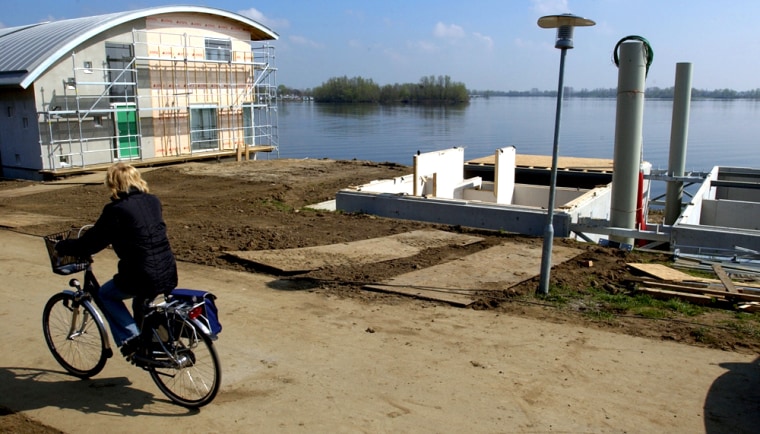This low-lying land has a new weapon in its never-ending battle with the tides: amphibian houses.
For centuries, the Dutch have built dikes to protect themselves from the sea. Now, with predictions of more frequent flooding due to climate change, they are looking for ways to live with water, not fight it.
That change of thinking is reflected at a new housing project in this central Dutch village about 60 miles southeast of Amsterdam. It is a community of amphibious homes.
Unlike the houseboats that line many Dutch canals or the floating villages of Asia, the several dozen homes are being built on solid ground. But they also are designed to float on flood water.
Each house is made of lightweight wood, and the concrete base is hollow, giving it ship-like buoyancy.
With no foundations anchored in the earth, the structure rests on the ground and is fastened to 15-foot-long mooring posts with sliding rings, allowing it to float upward should the river flood. All the electrical cables, water and sewage flow through flexible pipes inside the mooring piles.
The 700-square-foot structures are on the “wrong” side of a dike in a beautiful flood plain of one of the country’s main waterways, the Maas River, overlooking lush marshland and a harbor.
Housing also drives idea
That addresses another constant fight in the Netherlands — finding space for housing in Europe’s most densely populated country, says Chris Zevenbergen of Dura Vermeer, the company behind the project.
He says floating houses could help make up the 40 percent shortfall in land suitable for development over the next 50 years.
At a starting price of 260,000 euros, or about $310,000, for a house with three small bedrooms, the homes are at the high end of the market for a village like Maasbommel. But many have been sold, and the first residents are about to move in.
“They are pretty much just regular houses,” says builder Hans van de Beek. “The only difference is that when the water rises, they rise.”
Boats required
So, during times of high water, people will need a boat to get from the dike where they park their car to the “comfort” of their floating home.
For more than 1,000 years the Dutch have been holding back the sea, and even reclaiming it. Landfills and windmill-driven pumps have created vast fields, called polders, for new cities, pastures and cropland. If it weren’t for its system of dikes and canals, as much as half of the Netherlands could be submerged.
The country was hit by flooding twice in the past decade, in 1993 and 1995, causing billions of dollars in damage. In 1953, more than 1,800 people died during a deluge, referred to ever since simply as “the disaster.”
Scientists warn that global warming will make it worse. The U.N. Intergovernmental Panel of Climate Change predicts rainfall in the Netherlands could increase by up to 25 percent and the sea level could rise 43 inches in this century.
“Due to the changing climate, the Netherlands and its delta areas will be confronted with rising water,” Zevenbergen says. “This is a way for people to live in the low-lying areas that would otherwise be uninhabitable.”
